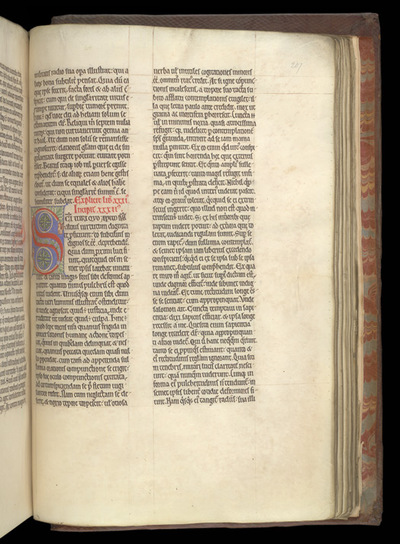Javascript must be enabled to continue!
Decorated Initial, In Gregory The Great's 'Commentary On The Book Of Job' f.207r
View through Europeana Collections
Gregory the Great (c.540-604) was pope (from 590
until his death), reputed inventor of 'Gregorian' chant, and one of
the most important authors of the early Middle Ages. His Commentary
on Job is a vast work, running to half a million words, divided
into 35 books, and is bound in as many as six volumes. This
manuscript contains Books 17-35, and was therefore presumably the
second half of a two-volume set that was apparently owned in the
Middle Ages by St. Mary's Priory, Bradenstoke (between Swindon and
Chippenham). Book XXXIII is introduced by an initial 'S' with
animal heads at each end, and is set against a rich blue
background. The page layout is typical of 12th-century monastic
manuscripts, with two columns of well-spaced text, ample margins,
and none of the apparatus intended to help readers, such as
running-titles, that would become common in the 13th
century.
Title: Decorated Initial, In Gregory The Great's 'Commentary On The
Book Of Job' f.207r
Description:
Gregory the Great (c.
540-604) was pope (from 590
until his death), reputed inventor of 'Gregorian' chant, and one of
the most important authors of the early Middle Ages.
His Commentary
on Job is a vast work, running to half a million words, divided
into 35 books, and is bound in as many as six volumes.
This
manuscript contains Books 17-35, and was therefore presumably the
second half of a two-volume set that was apparently owned in the
Middle Ages by St.
Mary's Priory, Bradenstoke (between Swindon and
Chippenham).
Book XXXIII is introduced by an initial 'S' with
animal heads at each end, and is set against a rich blue
background.
The page layout is typical of 12th-century monastic
manuscripts, with two columns of well-spaced text, ample margins,
and none of the apparatus intended to help readers, such as
running-titles, that would become common in the 13th
century.
Related Results
Breechcloth
Breechcloth
Breechcloth; probably Yanktonai; 1860-1870Wool, porcupine quills, sinew, metal, horsehair, pigments; 117.5 x 28.5 cm.\RMV 710-9; Herman F.C. ten Kate collection; purchased from tra...
Decorated Initial, In St. Gregory of Nazianzus' 'Eight
Orations' f.74r
Decorated Initial, In St. Gregory of Nazianzus' 'Eight
Orations' f.74r
St. Gregory of Nazianzus (c.325-389) wrote three
types of work: poetical (including epigrams, epitaphs, and
epistles), prose epistles, and orations. Gregory is widely
acknowledged ...
Decorated Initial And Ownership Inscription, In St. Gregory
of Nazianzus' 'Eight Orations'
Decorated Initial And Ownership Inscription, In St. Gregory
of Nazianzus' 'Eight Orations'
St. Gregory of Nazianzus (c.325-389) wrote three
types of work: poetical (including epigrams, epitaphs, and
epistles), prose epistles, and orations. Gregory is widely
acknowledged ...
Decorated Initial, In St. Gregory of Nazianzus's 'Eight
Orations' f.64r
Decorated Initial, In St. Gregory of Nazianzus's 'Eight
Orations' f.64r
St. Gregory of Nazianzus (c.325-389) wrote three
types of work: poetical (including epigrams, epitaphs, and
epistles), prose epistles, and orations. Gregory is widely
acknowledged ...
Decorated Initial, In St. Gregory of Nazianzus' 'Eight
Orations' f.84v
Decorated Initial, In St. Gregory of Nazianzus' 'Eight
Orations' f.84v
St. Gregory of Nazianzus (c.325-389) wrote three
types of work: poetical (including epigrams, epitaphs, and
epistles), prose epistles, and orations. Gregory is widely
acknowledged ...
Title Page: Illustrations of the Book of Job
Title Page: Illustrations of the Book of Job
Engraving, Illustrations of the Book of Job...




